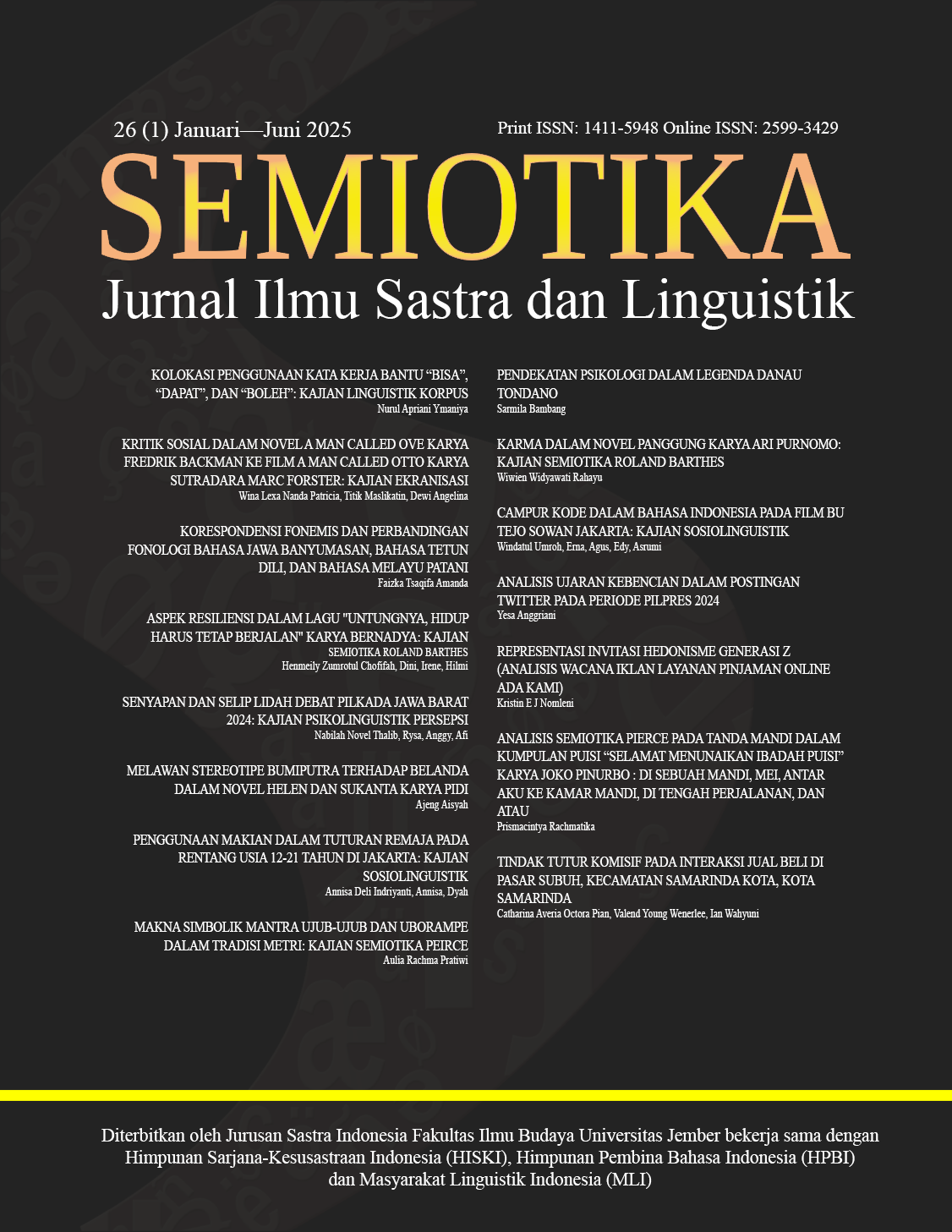KARMA DALAM NOVEL PANGGUNG KARYA ARI PURNOMO: KAJIAN SEMIOTIKA ROLAND BARTHES
Keywords:
the Panggung novel, Roland Barthes’s semiotics, denotation, connotation, myth of karmaAbstract
The study used the novel Panggung by Ari Purnomo as a material object and Roland Barthes’s studies of semiotics as a formal object. The novel depicts life in the stage world. The novel is also accompanied by facts about how the world of stage life lives both outside and inside the stage. This study aims to reveal the meaning of denotation, connotation, and the myth of karma in the novel Panggung. Roland Barthes’s semiotic studies were used to analyze the novel Panggung. This study is used to elaborate on the meaning of denotation as the first stage of dignification and to unravel the myth of karma as the content of the connotation form. The study used a qualitative descriptive method. The data collection techniques used are reading and note-taking techniques. From the results of the study, it was found that: (1) life in the stage world is no different from life in the real world. (2) The facts of the stage world depicted in the novel Panggung are closely related to life in the real world. These facts are expressed through the meaning of the denotation indicated by the author’s speech or the actions taken by the characters in the novel Panggung. (3) The advice of the karma myth is described using language not explicitly expressed through connotational meanings.
Downloads
References
Amalia, Atika Rahma dan Syaifullah, Aceng Ruhendi. 2024. “Representasi Semiotika Roland Barthes dalam novel Ours karya Adrindia Ryandisza”. Jurnal SEMIOTIKA: Jurnal Ilmu Sastra dan Linguistik, Vol. 25 No. 2.
Barthes, Roland. 1972. Mythologies. New York: The Noonday Press.
Bintari, Wulan Probo. 2021. “Makna Tekad Dalam Cerkak Ratu Adil Karya Suwardi Endraswara Analisis Semiotik Roland Barthes”. Skripsi, Universitas Gadjah Mada, Yogyakarta.
Hanifah, Noor. 2022. “Analisis Novel “Bumi Manusia” Karya Pramoedya Ananta Toer: Kajian Semiotika Roland Barthes (Analysis of The Novel “Bumi Manusia” By Pramoedya Ananta Toer: Roland Barthes Semiotics Study)”. Jurnal Bahasa, Sastra dan Pembelajarannya, Vol 12, No.2.
Hilda, Fadhla. 2022. “Makna Tamu Pada Novel Tamu Karya Wisran Hadi: Analisis Semiotika Roland Barthes”. Tesis, Universitas Andalas.
Muliadi. 2017. Telaah Prosa. Makassar: De La Macca.
Nurafia, R. 2021. “Mitos dalam Novel Haniyah dan Ala di Rumah Teteruga Karya Erni Aladjai”. Jurnal Skripta, 7(2).
Padmosoekotjo, S. (tth). Ngengrengan Kasusastran Djawa I. Jogjakarta: Hien Hoo Sing.
Purnomo, Ari. 2019. Panggung. Yogyakarta: Dinas Kebudayaan (Kundha Kabudayan) DIY.
Sobur, Alex. 2004. Semiotika Komunikasi. Bandung: PT. Remaja Rosdakarya.
Wellek, Rene., dan Austin Warren. 1995. Teori Kesusastraan. Jakarta: Gramedia.
Wiyatmi. 2012. Kritik Sastra Feminis Teori dan Aplikasinya dalam Sastra Indonesia. Yogyakarta. Penerbit Ombak.
Downloads
Published
Issue
Section
License
Copyright (c) 2025 Semiotika: Jurnal Ilmu Sastra dan Linguistik

This work is licensed under a Creative Commons Attribution-ShareAlike 4.0 International License.
SEMIOTIKA has CC-BY-SA or an equivalent license as the optimal license for the publication, distribution, use, and reuse of scholarly work. Authors who publish with this journal retain copyright and grant the journal right of first publication with the work simultaneously licensed under a Creative Commons Attribution-ShareAlike 4.0 International License that allows others to share the work with an acknowledgment of the work's authorship and initial publication in this journal.
Attribution-ShareAlike
CC BY-SA


